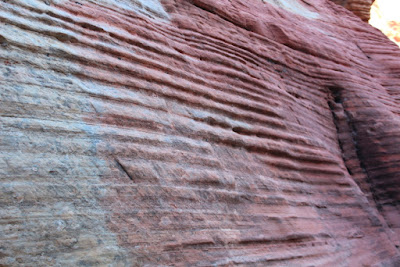 |
| Picture by Kolohe |
Looking back at the trailhead from the top of the first knoll.
The peak is too steep to ascend from the west side, so the trail circles around to the east side of the mountain where there is a gradual incline to the peak.
Although you would not know it now, this area was once covered with water. On the south side of the peak fossilized seaweed can be found covering many of the rocks.
We even found a seashell!
Conglomerate and other seabed rocks were also strewn about the area. Some of the rocks contain large cuts from a later period in time when glaciers moved through the area.
Various shades of lichen were also visible on the rocks.
 |
| Lichen (multiple species are found in the area) |
Part way up the east side of the mountain we found an old camp site and a pile of rocks that may have been a grave site. If it was a grave site, it was probably for an animal because it appeared to be too new for a human grave.
Several trees in the area contained large growths of Mistletoe, which is a parasite. Wikipedia states "Mistletoe species grow on a wide range of host trees, some of which experience side effects including reduced growth, stunting, and loss of infested outer branches. A heavy infestation may also kill the host plant."
 |
| Mistletoe (Phoradendron leucarpum) |
 |
| Strawberry Hedgehog Cactus (Echinocereus engelmannii) |
 |
| Pencil Cholla Cactus (Opuntia ramosissima) |
 |
| Mojave Yucca (Yucca schidigera) |
 |
| Fishhook Cactus (Mammillaria tetrancistra) |
 |
| Beavertail Cactus (Opuntia basilaris) |
 |
| Nevada Agave (Agave utahensis) |
The interior trunk of a Joshua Tree after it died.
 |
| Joshua Tree (Yucca brevifolia) |
 |
| Picture by Kolohe |
Looking southeast toward Las Vegas. Red Rock Hotel/Casino is in the foreground.
Just as we were finishing the hike, two horseback riders passed us going the other direction.
Kolohe also provided me with some panoramic pictures!
BONUS HISTORICAL PICTURES
I was really happy when my Mom made me a new snow suit. Years later, Grandsons Andrew and Carter also wore the snow suit. (She apparently added fur to the cap and jacket collar sometime between the pictures.)
Because my Mother did not have any daughters, and she liked to sew girls clothes, she also made me a girl's dress!














































































